Accounting Decision Support Tools Assessment Item 3 Solution [Date]
VerifiedAdded on 2021/06/14
|14
|1275
|19
Homework Assignment
AI Summary
This assignment solution addresses various aspects of accounting decision support tools. Question 1 focuses on the decision-making process, payoff matrices, and different decision models like optimistic, pessimistic, and Laplace rules, alongside maximizing expected value and determining optimal seafood purchase quantities based on normal distribution. Question 2 is missing. Question 3 presents a simulation model for hotel room costs, analyzing overbooking policies and recommending improvements to maximize profit. Question 4 involves regression analysis, comparing models based on mileage and age to predict car prices, and discussing the validity of multiple regression assumptions, including multicollinearity. Finally, Question 5 covers cost-volume-profit (CVP) analysis, calculating break-even points and determining production units for profit targets, including a scenario with two products and a fixed production ratio. The solution integrates financial analysis, statistical methods, and practical business recommendations.
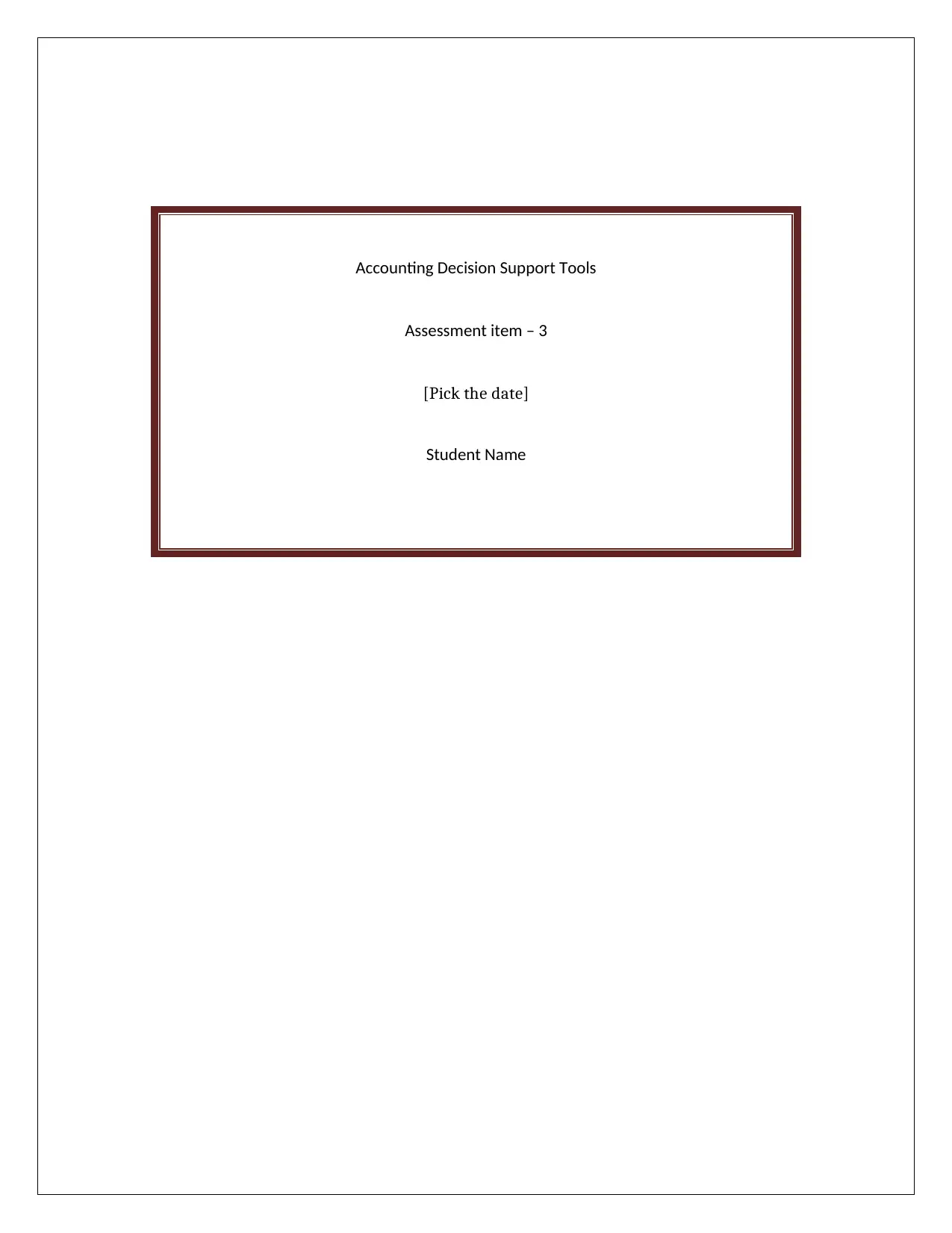
Accounting Decision Support Tools
Assessment item – 3
[Pick the date]
Student Name
Assessment item – 3
[Pick the date]
Student Name
Paraphrase This Document
Need a fresh take? Get an instant paraphrase of this document with our AI Paraphraser
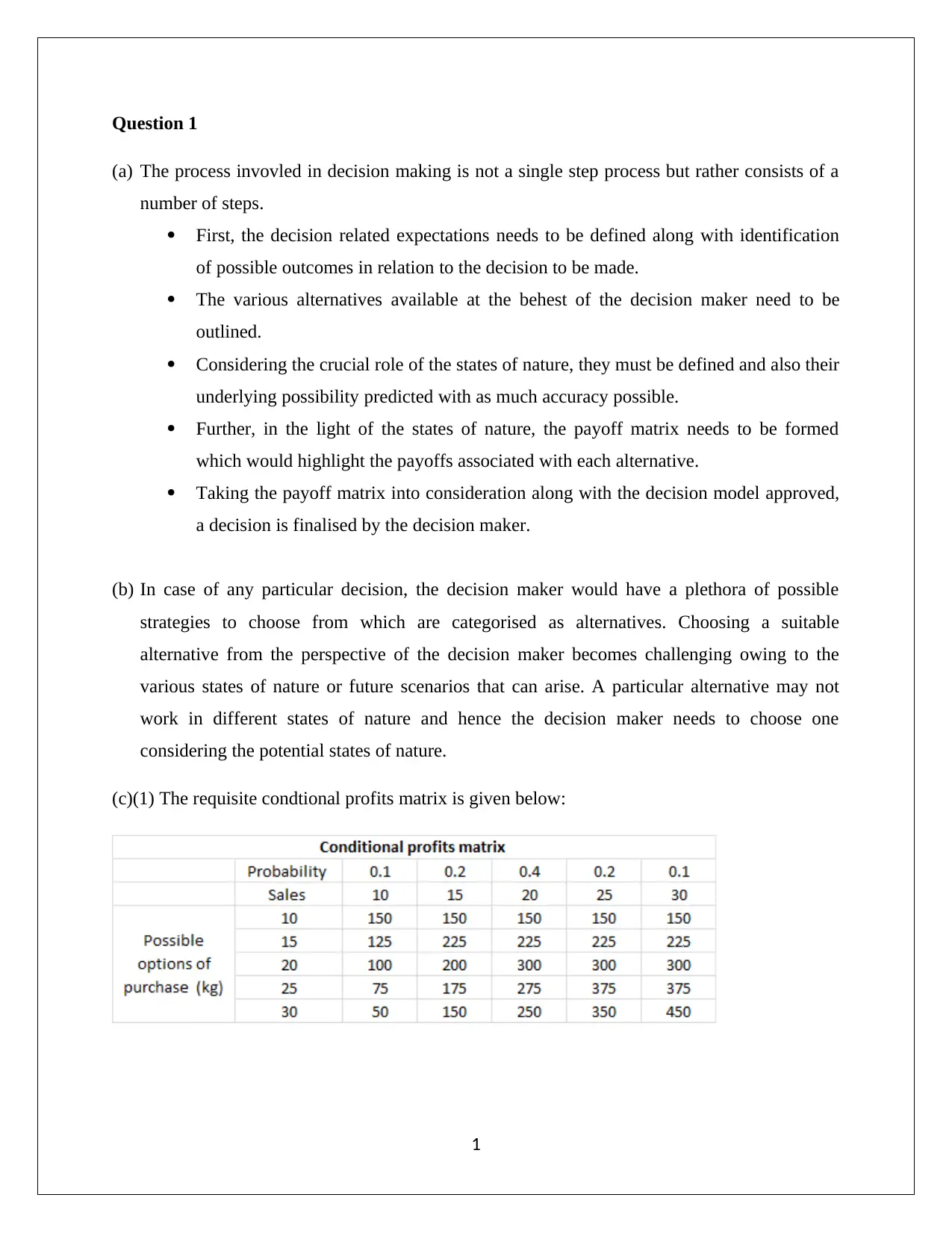
Question 1
(a) The process invovled in decision making is not a single step process but rather consists of a
number of steps.
First, the decision related expectations needs to be defined along with identification
of possible outcomes in relation to the decision to be made.
The various alternatives available at the behest of the decision maker need to be
outlined.
Considering the crucial role of the states of nature, they must be defined and also their
underlying possibility predicted with as much accuracy possible.
Further, in the light of the states of nature, the payoff matrix needs to be formed
which would highlight the payoffs associated with each alternative.
Taking the payoff matrix into consideration along with the decision model approved,
a decision is finalised by the decision maker.
(b) In case of any particular decision, the decision maker would have a plethora of possible
strategies to choose from which are categorised as alternatives. Choosing a suitable
alternative from the perspective of the decision maker becomes challenging owing to the
various states of nature or future scenarios that can arise. A particular alternative may not
work in different states of nature and hence the decision maker needs to choose one
considering the potential states of nature.
(c)(1) The requisite condtional profits matrix is given below:
1
(a) The process invovled in decision making is not a single step process but rather consists of a
number of steps.
First, the decision related expectations needs to be defined along with identification
of possible outcomes in relation to the decision to be made.
The various alternatives available at the behest of the decision maker need to be
outlined.
Considering the crucial role of the states of nature, they must be defined and also their
underlying possibility predicted with as much accuracy possible.
Further, in the light of the states of nature, the payoff matrix needs to be formed
which would highlight the payoffs associated with each alternative.
Taking the payoff matrix into consideration along with the decision model approved,
a decision is finalised by the decision maker.
(b) In case of any particular decision, the decision maker would have a plethora of possible
strategies to choose from which are categorised as alternatives. Choosing a suitable
alternative from the perspective of the decision maker becomes challenging owing to the
various states of nature or future scenarios that can arise. A particular alternative may not
work in different states of nature and hence the decision maker needs to choose one
considering the potential states of nature.
(c)(1) The requisite condtional profits matrix is given below:
1
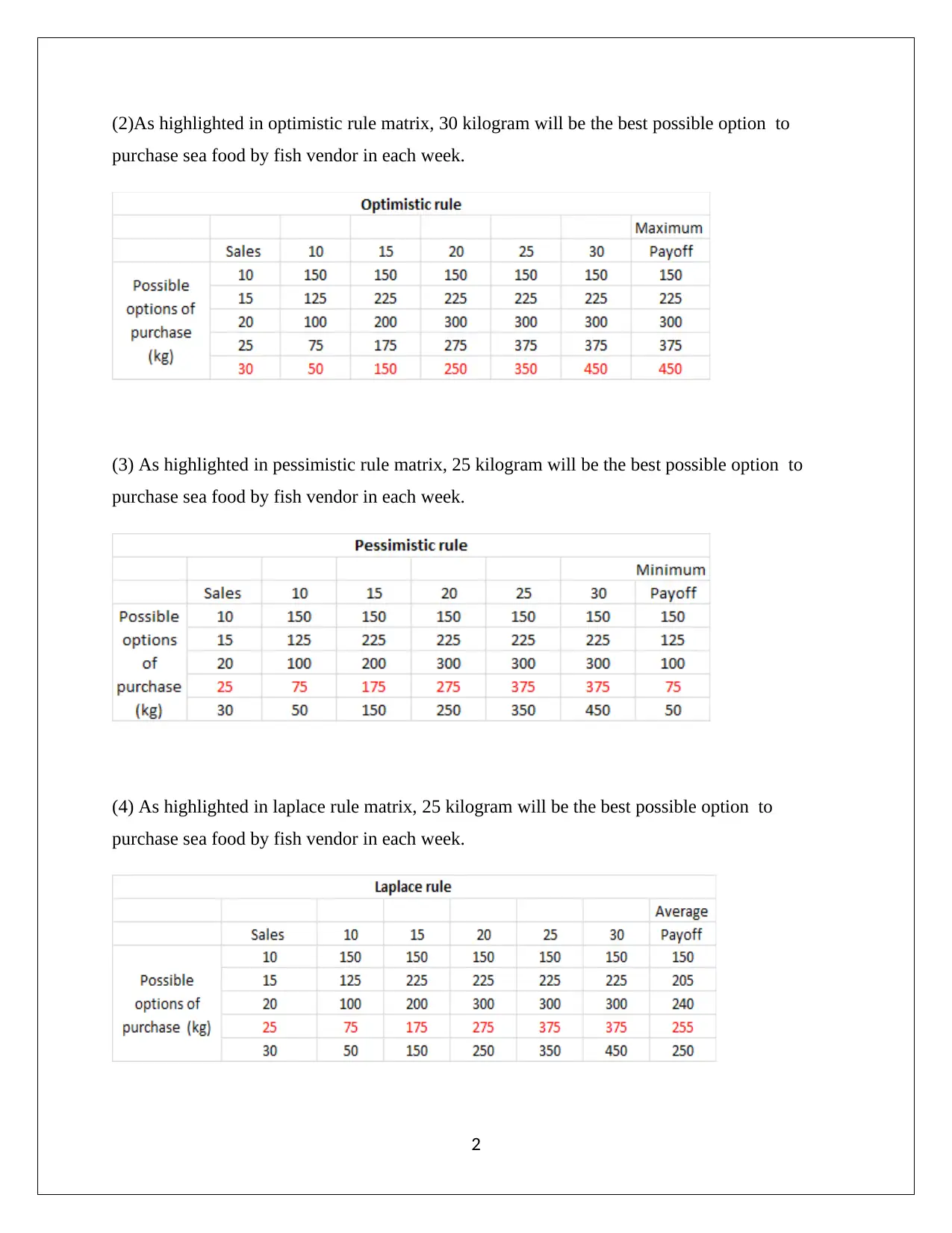
(2)As highlighted in optimistic rule matrix, 30 kilogram will be the best possible option to
purchase sea food by fish vendor in each week.
(3) As highlighted in pessimistic rule matrix, 25 kilogram will be the best possible option to
purchase sea food by fish vendor in each week.
(4) As highlighted in laplace rule matrix, 25 kilogram will be the best possible option to
purchase sea food by fish vendor in each week.
2
purchase sea food by fish vendor in each week.
(3) As highlighted in pessimistic rule matrix, 25 kilogram will be the best possible option to
purchase sea food by fish vendor in each week.
(4) As highlighted in laplace rule matrix, 25 kilogram will be the best possible option to
purchase sea food by fish vendor in each week.
2
⊘ This is a preview!⊘
Do you want full access?
Subscribe today to unlock all pages.

Trusted by 1+ million students worldwide
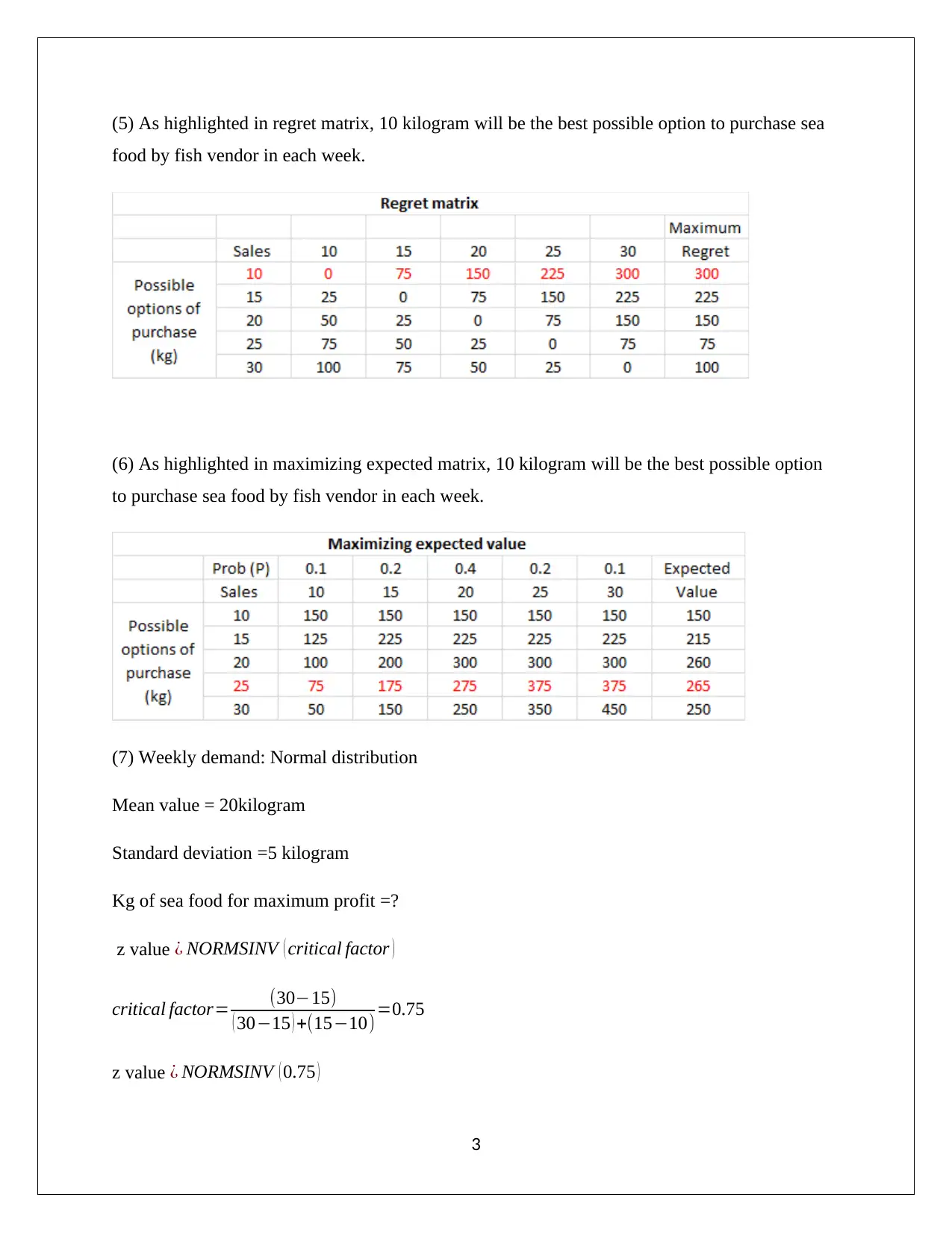
(5) As highlighted in regret matrix, 10 kilogram will be the best possible option to purchase sea
food by fish vendor in each week.
(6) As highlighted in maximizing expected matrix, 10 kilogram will be the best possible option
to purchase sea food by fish vendor in each week.
(7) Weekly demand: Normal distribution
Mean value = 20kilogram
Standard deviation =5 kilogram
Kg of sea food for maximum profit =?
z value ¿ NORMSINV ( critical factor )
critical factor= (30−15)
( 30−15 ) +(15−10)=0.75
z value ¿ NORMSINV ( 0.75 )
3
food by fish vendor in each week.
(6) As highlighted in maximizing expected matrix, 10 kilogram will be the best possible option
to purchase sea food by fish vendor in each week.
(7) Weekly demand: Normal distribution
Mean value = 20kilogram
Standard deviation =5 kilogram
Kg of sea food for maximum profit =?
z value ¿ NORMSINV ( critical factor )
critical factor= (30−15)
( 30−15 ) +(15−10)=0.75
z value ¿ NORMSINV ( 0.75 )
3
Paraphrase This Document
Need a fresh take? Get an instant paraphrase of this document with our AI Paraphraser
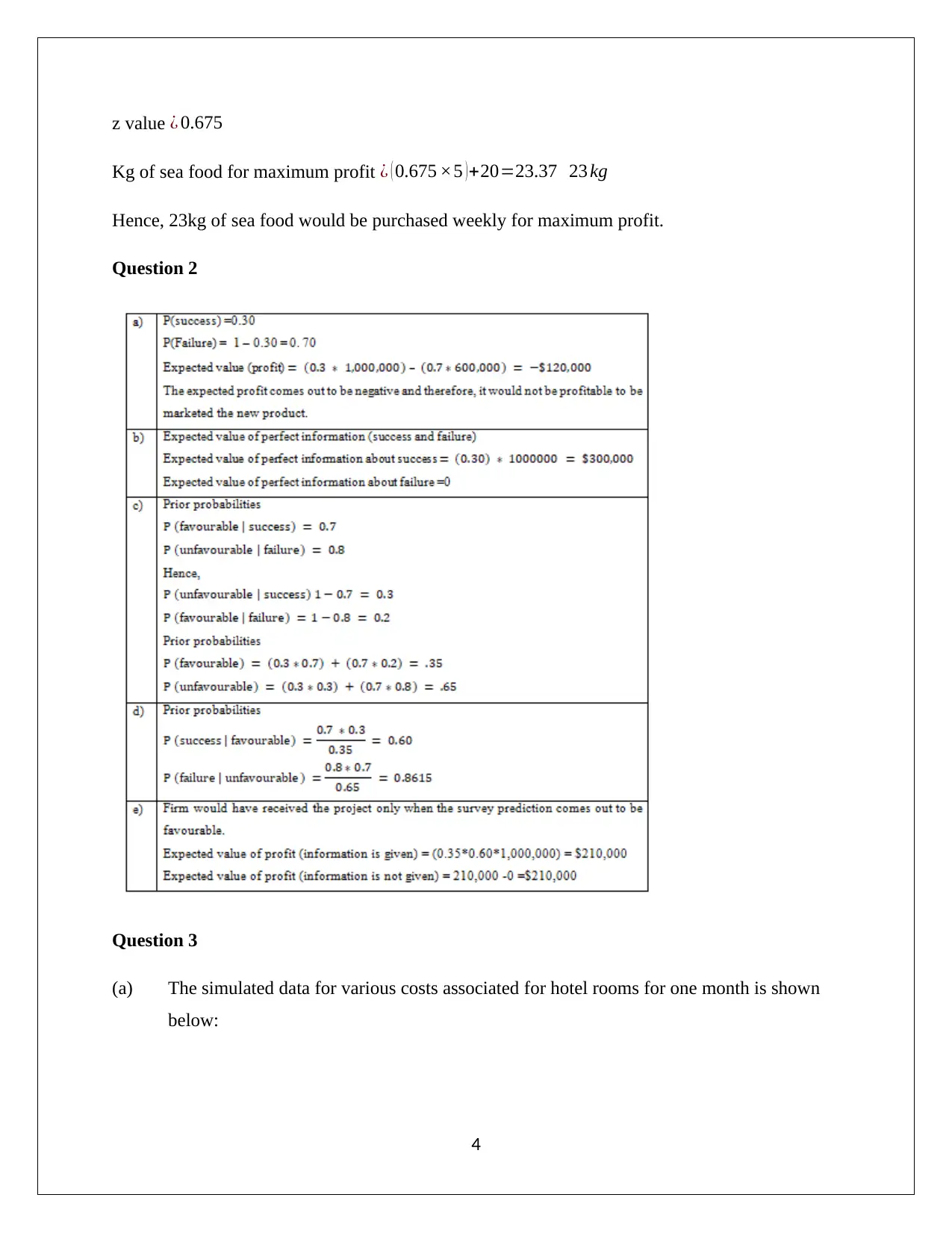
z value ¿ 0.675
Kg of sea food for maximum profit ¿ ( 0.675 ×5 )+20=23.37 23 kg
Hence, 23kg of sea food would be purchased weekly for maximum profit.
Question 2
Question 3
(a) The simulated data for various costs associated for hotel rooms for one month is shown
below:
4
Kg of sea food for maximum profit ¿ ( 0.675 ×5 )+20=23.37 23 kg
Hence, 23kg of sea food would be purchased weekly for maximum profit.
Question 2
Question 3
(a) The simulated data for various costs associated for hotel rooms for one month is shown
below:
4
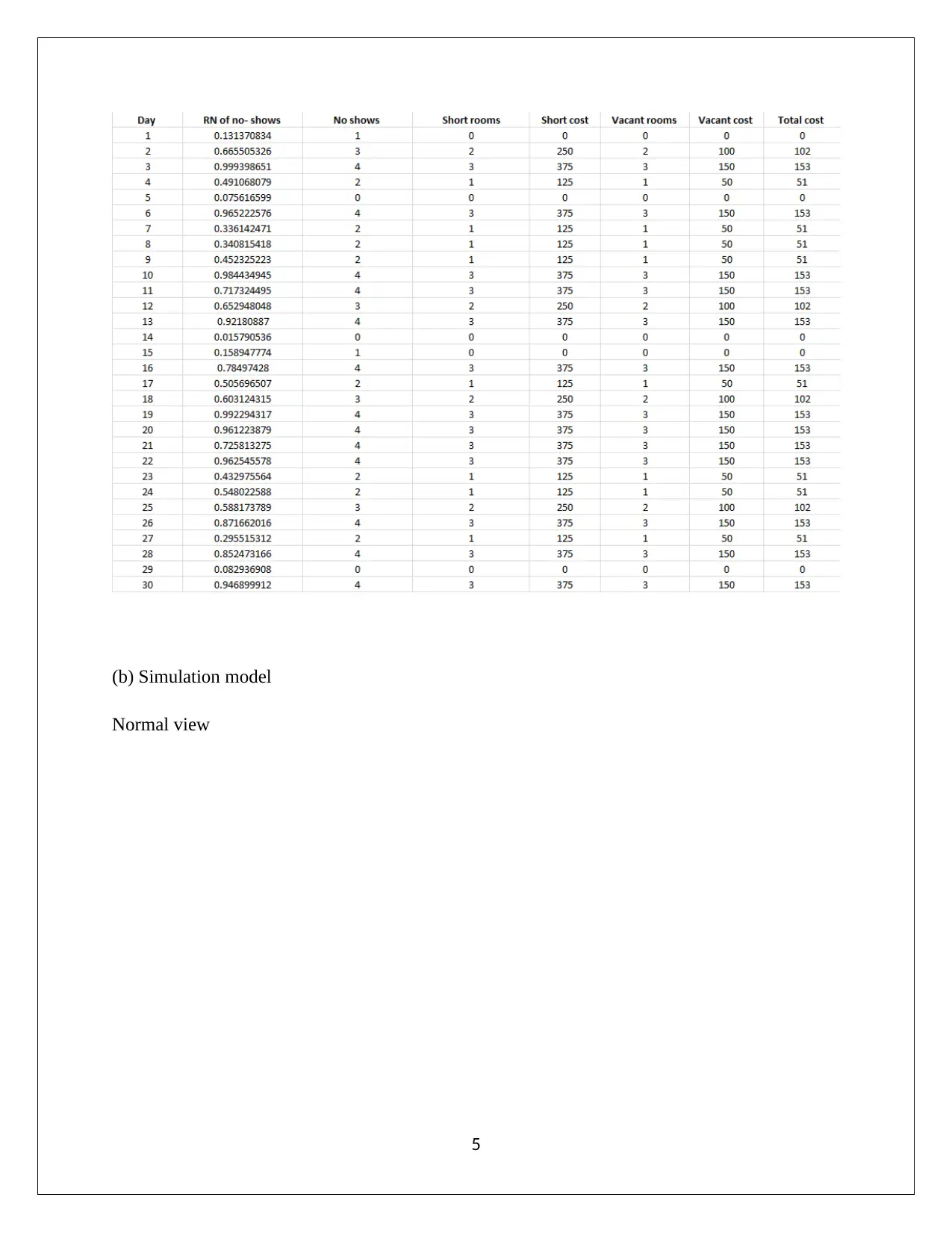
(b) Simulation model
Normal view
5
Normal view
5
⊘ This is a preview!⊘
Do you want full access?
Subscribe today to unlock all pages.

Trusted by 1+ million students worldwide
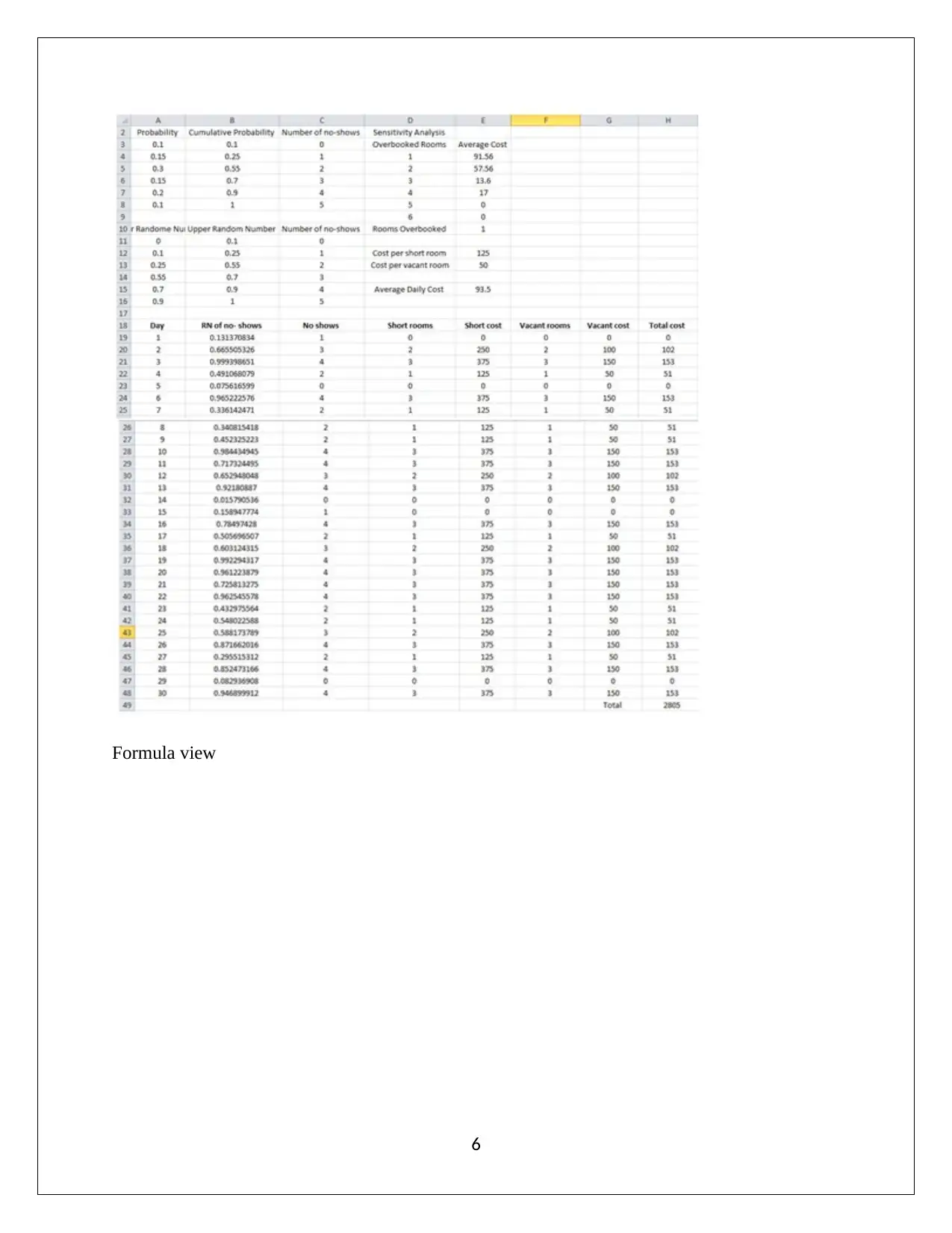
Formula view
6
6
Paraphrase This Document
Need a fresh take? Get an instant paraphrase of this document with our AI Paraphraser
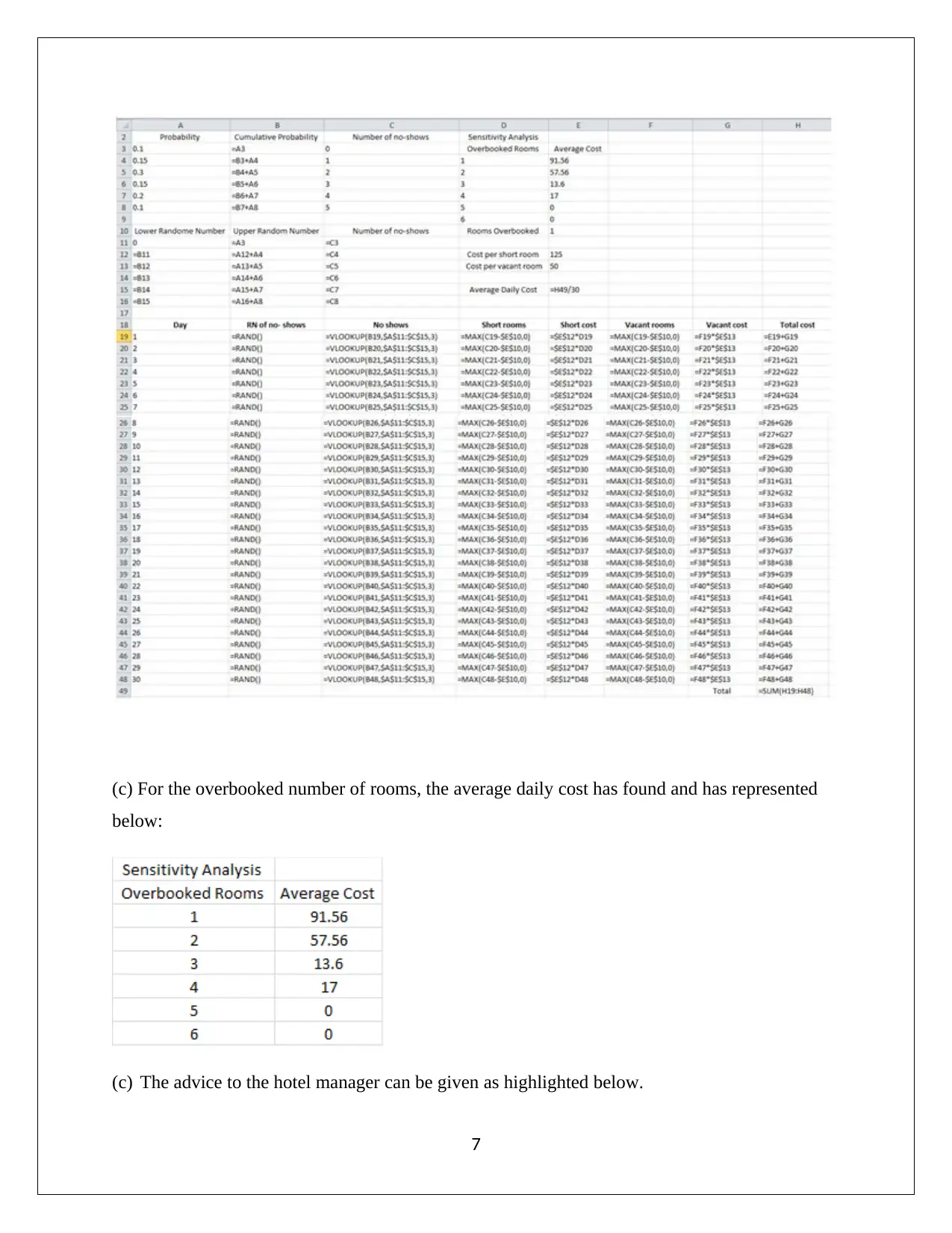
(c) For the overbooked number of rooms, the average daily cost has found and has represented
below:
(c) The advice to the hotel manager can be given as highlighted below.
7
below:
(c) The advice to the hotel manager can be given as highlighted below.
7
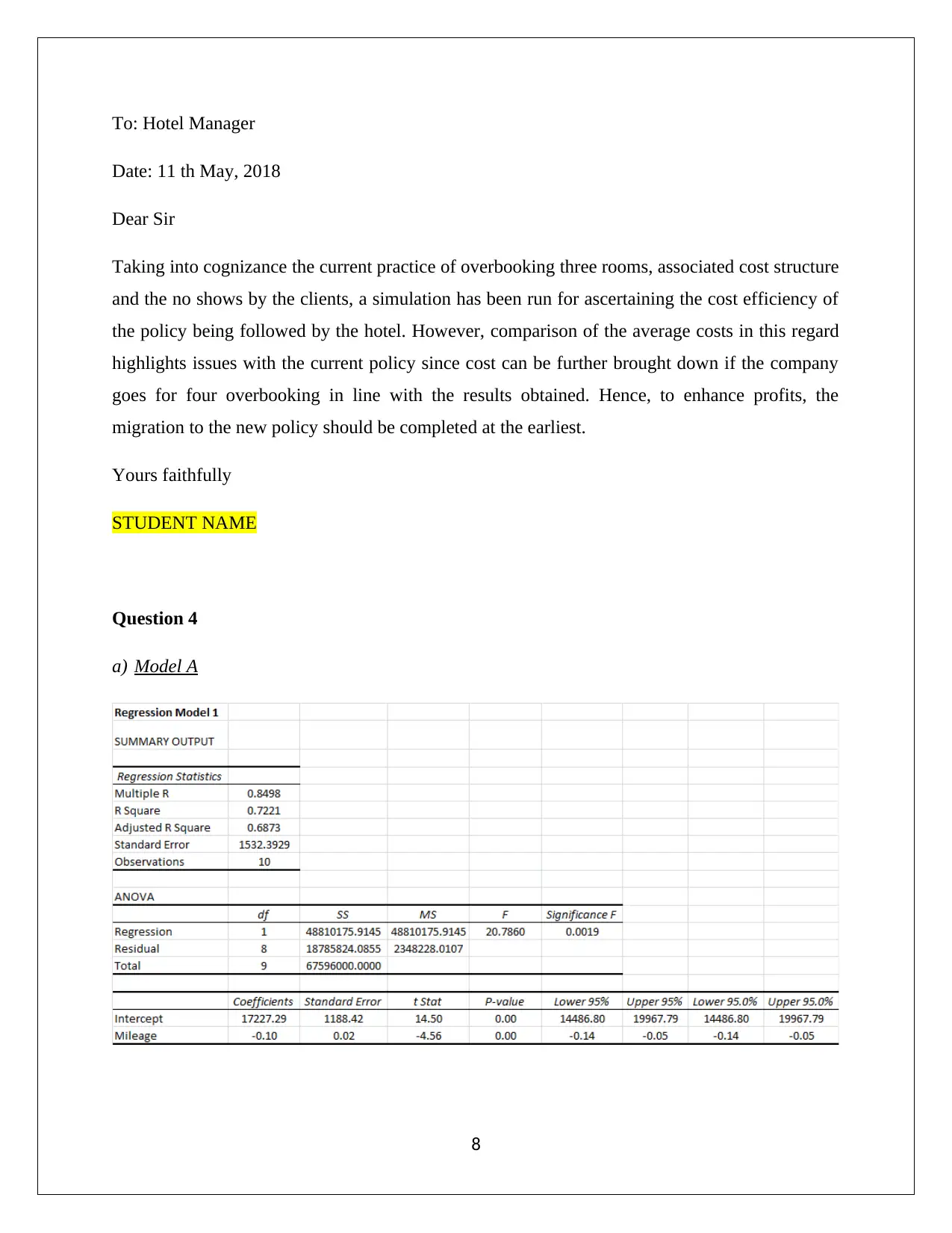
To: Hotel Manager
Date: 11 th May, 2018
Dear Sir
Taking into cognizance the current practice of overbooking three rooms, associated cost structure
and the no shows by the clients, a simulation has been run for ascertaining the cost efficiency of
the policy being followed by the hotel. However, comparison of the average costs in this regard
highlights issues with the current policy since cost can be further brought down if the company
goes for four overbooking in line with the results obtained. Hence, to enhance profits, the
migration to the new policy should be completed at the earliest.
Yours faithfully
STUDENT NAME
Question 4
a) Model A
8
Date: 11 th May, 2018
Dear Sir
Taking into cognizance the current practice of overbooking three rooms, associated cost structure
and the no shows by the clients, a simulation has been run for ascertaining the cost efficiency of
the policy being followed by the hotel. However, comparison of the average costs in this regard
highlights issues with the current policy since cost can be further brought down if the company
goes for four overbooking in line with the results obtained. Hence, to enhance profits, the
migration to the new policy should be completed at the earliest.
Yours faithfully
STUDENT NAME
Question 4
a) Model A
8
⊘ This is a preview!⊘
Do you want full access?
Subscribe today to unlock all pages.

Trusted by 1+ million students worldwide
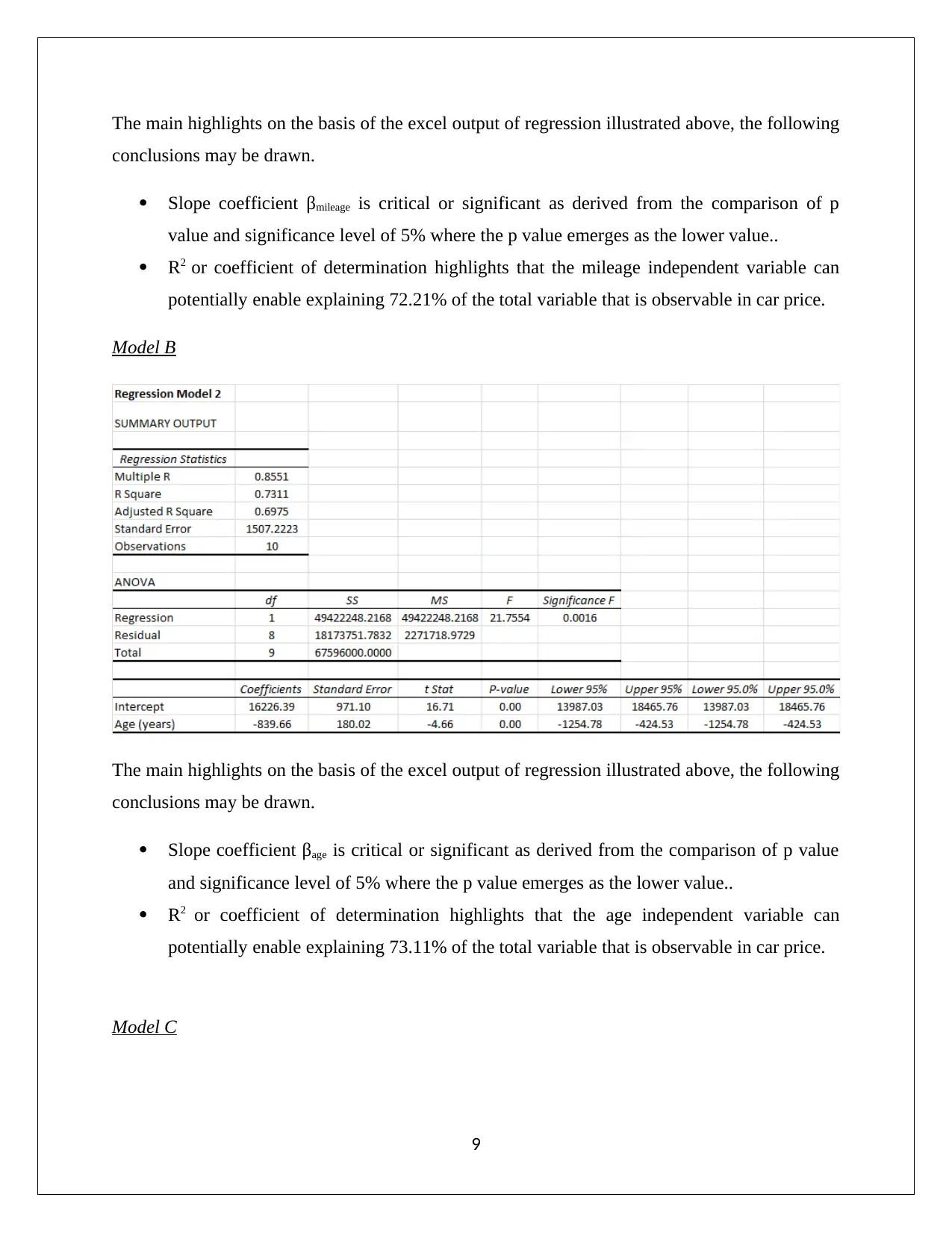
The main highlights on the basis of the excel output of regression illustrated above, the following
conclusions may be drawn.
Slope coefficient βmileage is critical or significant as derived from the comparison of p
value and significance level of 5% where the p value emerges as the lower value..
R2 or coefficient of determination highlights that the mileage independent variable can
potentially enable explaining 72.21% of the total variable that is observable in car price.
Model B
The main highlights on the basis of the excel output of regression illustrated above, the following
conclusions may be drawn.
Slope coefficient βage is critical or significant as derived from the comparison of p value
and significance level of 5% where the p value emerges as the lower value..
R2 or coefficient of determination highlights that the age independent variable can
potentially enable explaining 73.11% of the total variable that is observable in car price.
Model C
9
conclusions may be drawn.
Slope coefficient βmileage is critical or significant as derived from the comparison of p
value and significance level of 5% where the p value emerges as the lower value..
R2 or coefficient of determination highlights that the mileage independent variable can
potentially enable explaining 72.21% of the total variable that is observable in car price.
Model B
The main highlights on the basis of the excel output of regression illustrated above, the following
conclusions may be drawn.
Slope coefficient βage is critical or significant as derived from the comparison of p value
and significance level of 5% where the p value emerges as the lower value..
R2 or coefficient of determination highlights that the age independent variable can
potentially enable explaining 73.11% of the total variable that is observable in car price.
Model C
9
Paraphrase This Document
Need a fresh take? Get an instant paraphrase of this document with our AI Paraphraser
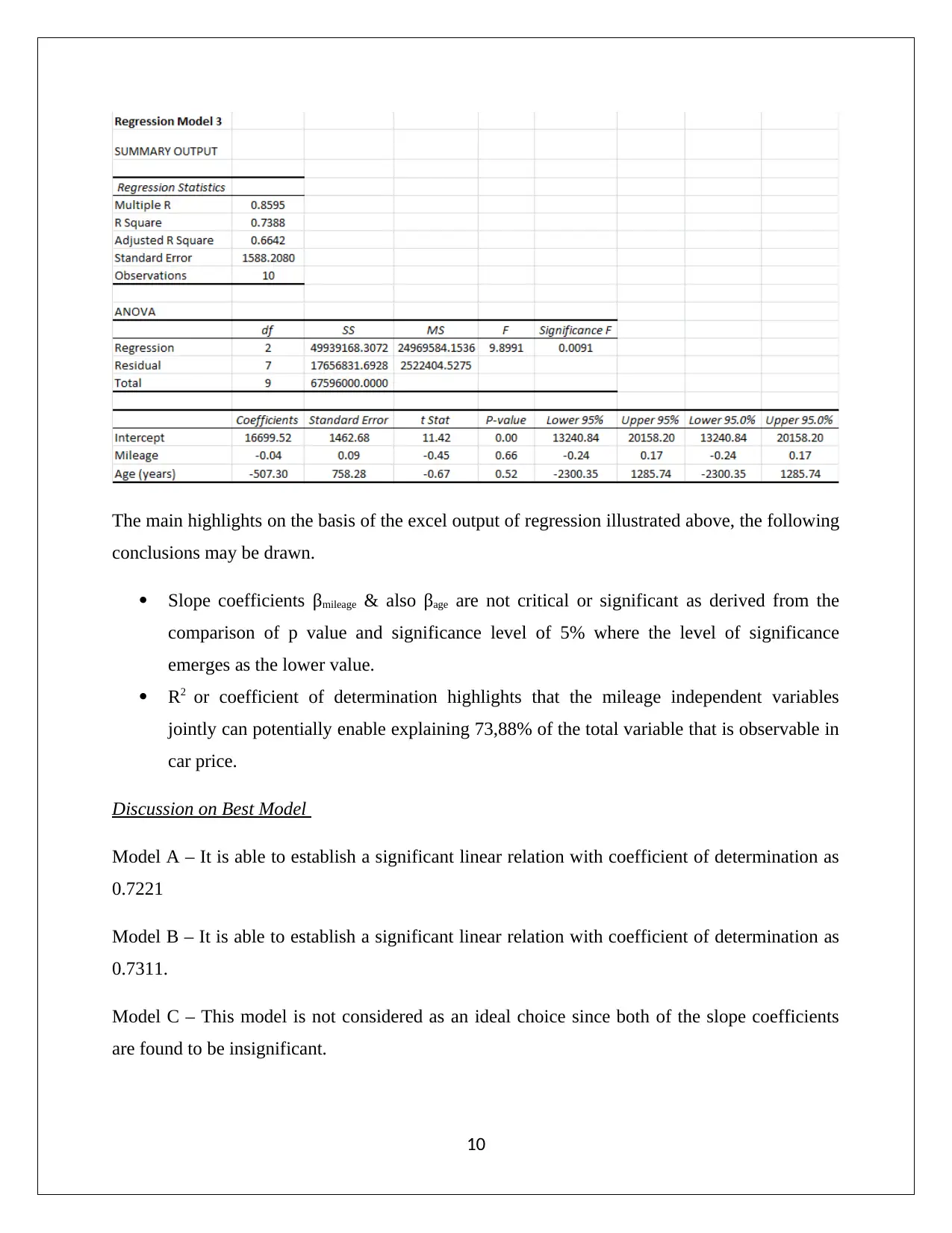
The main highlights on the basis of the excel output of regression illustrated above, the following
conclusions may be drawn.
Slope coefficients βmileage & also βage are not critical or significant as derived from the
comparison of p value and significance level of 5% where the level of significance
emerges as the lower value.
R2 or coefficient of determination highlights that the mileage independent variables
jointly can potentially enable explaining 73,88% of the total variable that is observable in
car price.
Discussion on Best Model
Model A – It is able to establish a significant linear relation with coefficient of determination as
0.7221
Model B – It is able to establish a significant linear relation with coefficient of determination as
0.7311.
Model C – This model is not considered as an ideal choice since both of the slope coefficients
are found to be insignificant.
10
conclusions may be drawn.
Slope coefficients βmileage & also βage are not critical or significant as derived from the
comparison of p value and significance level of 5% where the level of significance
emerges as the lower value.
R2 or coefficient of determination highlights that the mileage independent variables
jointly can potentially enable explaining 73,88% of the total variable that is observable in
car price.
Discussion on Best Model
Model A – It is able to establish a significant linear relation with coefficient of determination as
0.7221
Model B – It is able to establish a significant linear relation with coefficient of determination as
0.7311.
Model C – This model is not considered as an ideal choice since both of the slope coefficients
are found to be insignificant.
10
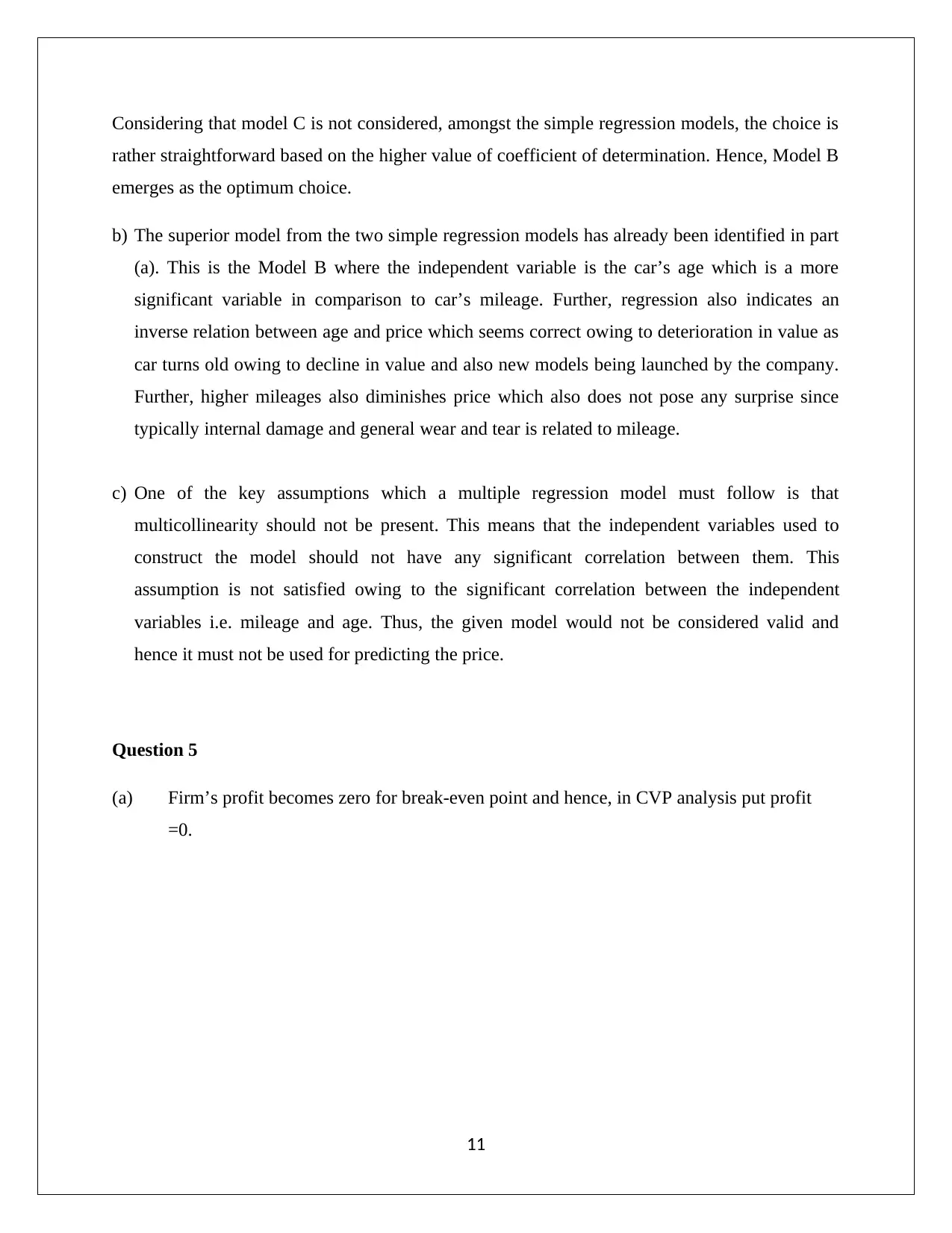
Considering that model C is not considered, amongst the simple regression models, the choice is
rather straightforward based on the higher value of coefficient of determination. Hence, Model B
emerges as the optimum choice.
b) The superior model from the two simple regression models has already been identified in part
(a). This is the Model B where the independent variable is the car’s age which is a more
significant variable in comparison to car’s mileage. Further, regression also indicates an
inverse relation between age and price which seems correct owing to deterioration in value as
car turns old owing to decline in value and also new models being launched by the company.
Further, higher mileages also diminishes price which also does not pose any surprise since
typically internal damage and general wear and tear is related to mileage.
c) One of the key assumptions which a multiple regression model must follow is that
multicollinearity should not be present. This means that the independent variables used to
construct the model should not have any significant correlation between them. This
assumption is not satisfied owing to the significant correlation between the independent
variables i.e. mileage and age. Thus, the given model would not be considered valid and
hence it must not be used for predicting the price.
Question 5
(a) Firm’s profit becomes zero for break-even point and hence, in CVP analysis put profit
=0.
11
rather straightforward based on the higher value of coefficient of determination. Hence, Model B
emerges as the optimum choice.
b) The superior model from the two simple regression models has already been identified in part
(a). This is the Model B where the independent variable is the car’s age which is a more
significant variable in comparison to car’s mileage. Further, regression also indicates an
inverse relation between age and price which seems correct owing to deterioration in value as
car turns old owing to decline in value and also new models being launched by the company.
Further, higher mileages also diminishes price which also does not pose any surprise since
typically internal damage and general wear and tear is related to mileage.
c) One of the key assumptions which a multiple regression model must follow is that
multicollinearity should not be present. This means that the independent variables used to
construct the model should not have any significant correlation between them. This
assumption is not satisfied owing to the significant correlation between the independent
variables i.e. mileage and age. Thus, the given model would not be considered valid and
hence it must not be used for predicting the price.
Question 5
(a) Firm’s profit becomes zero for break-even point and hence, in CVP analysis put profit
=0.
11
⊘ This is a preview!⊘
Do you want full access?
Subscribe today to unlock all pages.

Trusted by 1+ million students worldwide
1 out of 14
Related Documents
Your All-in-One AI-Powered Toolkit for Academic Success.
+13062052269
info@desklib.com
Available 24*7 on WhatsApp / Email
![[object Object]](/_next/static/media/star-bottom.7253800d.svg)
Unlock your academic potential
Copyright © 2020–2025 A2Z Services. All Rights Reserved. Developed and managed by ZUCOL.



![Assignment: Accounting Decision Support Tools - [Date] - Finance](/_next/image/?url=https%3A%2F%2Fdesklib.com%2Fmedia%2Fimages%2Fga%2F85e3fe63d61d4af3a506409b3f137201.jpg&w=256&q=75)

